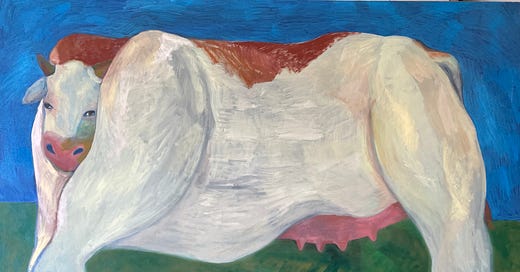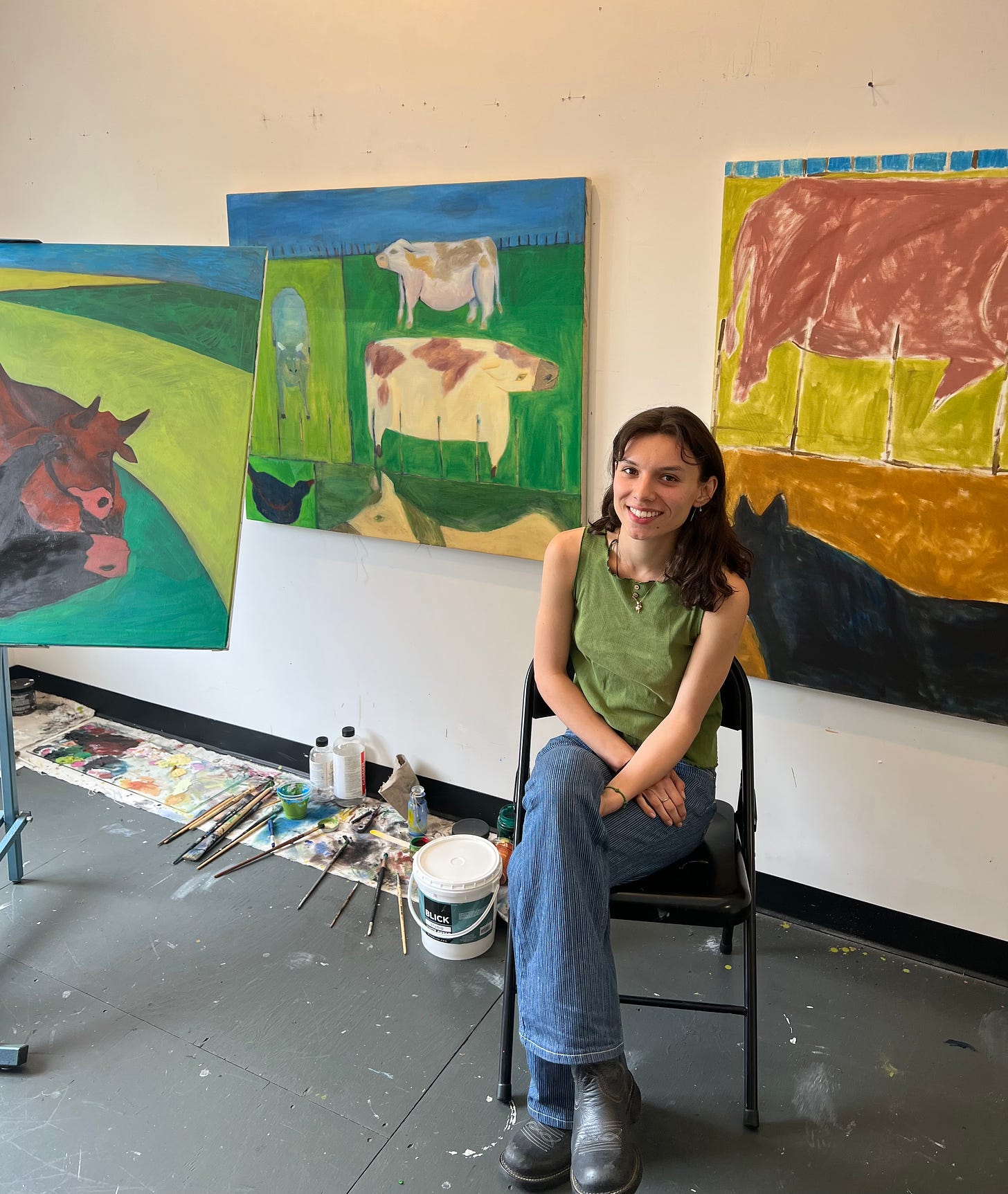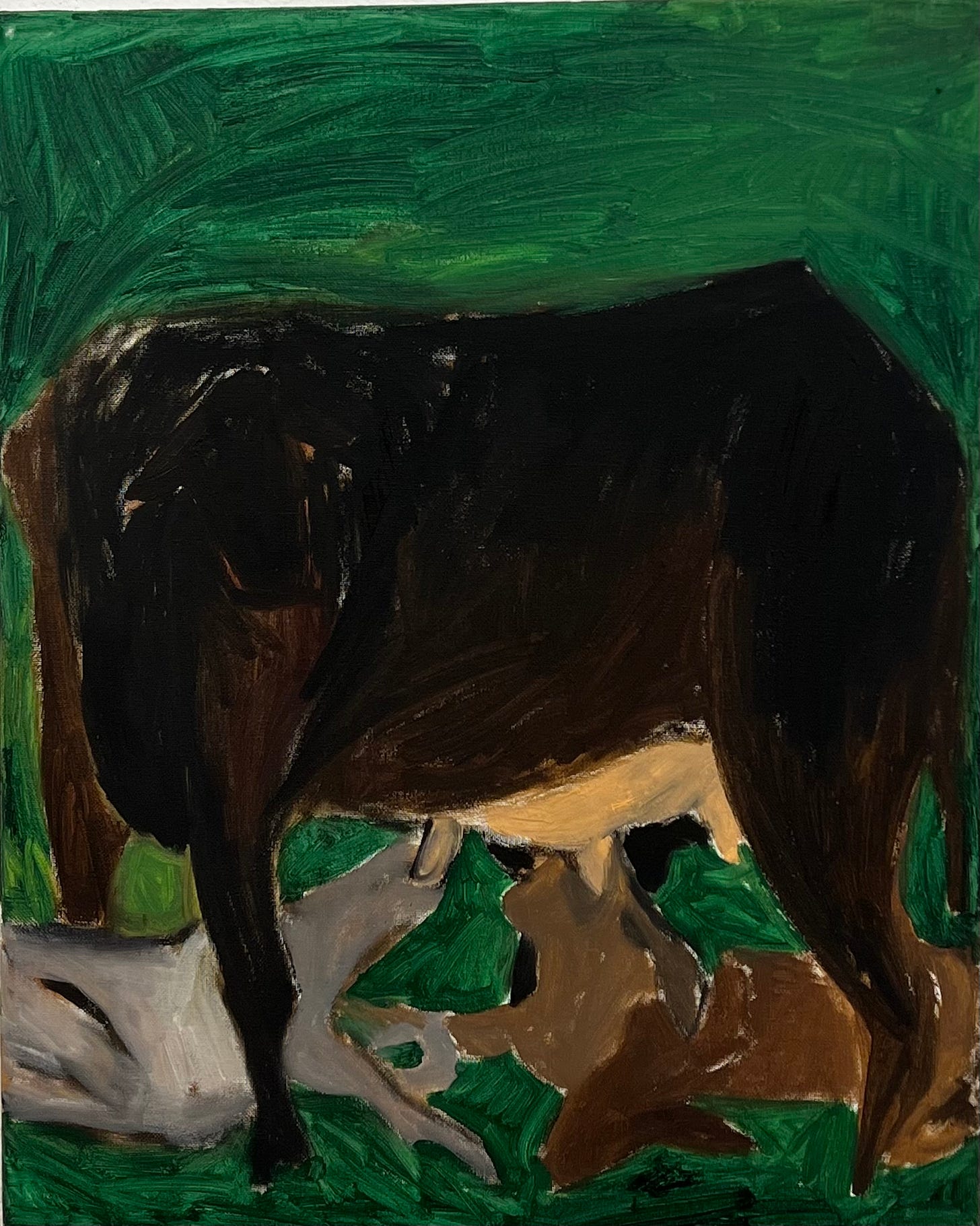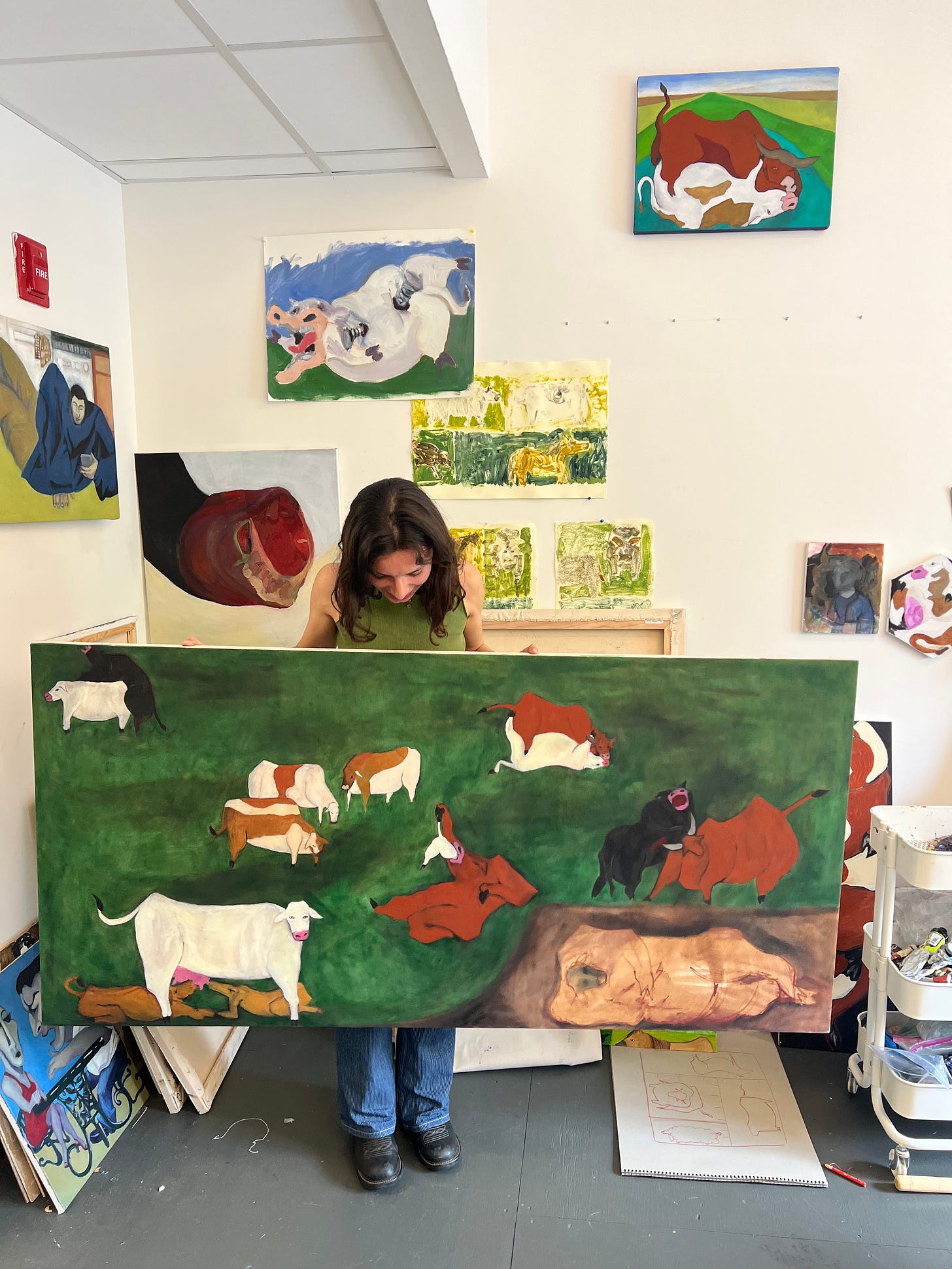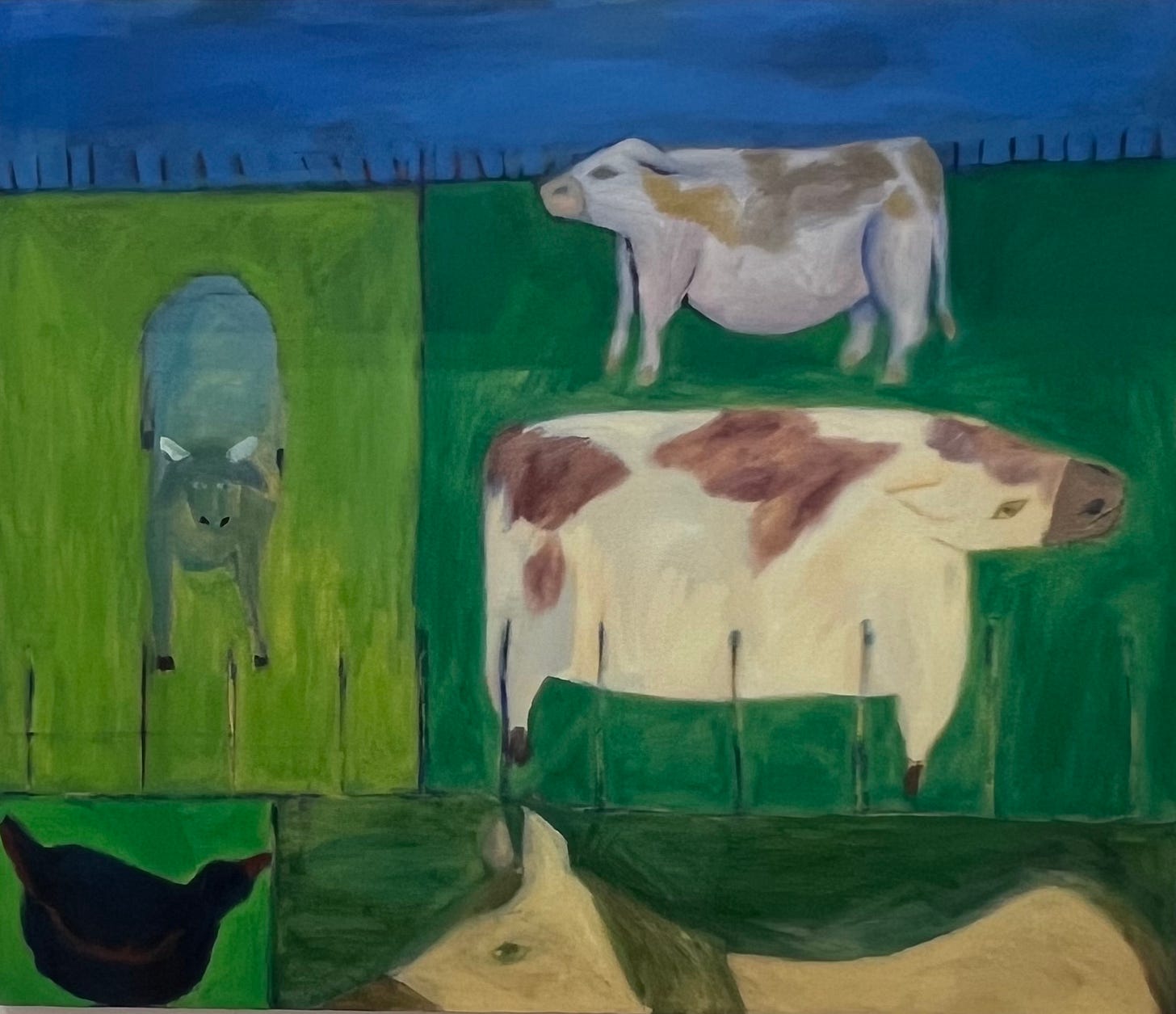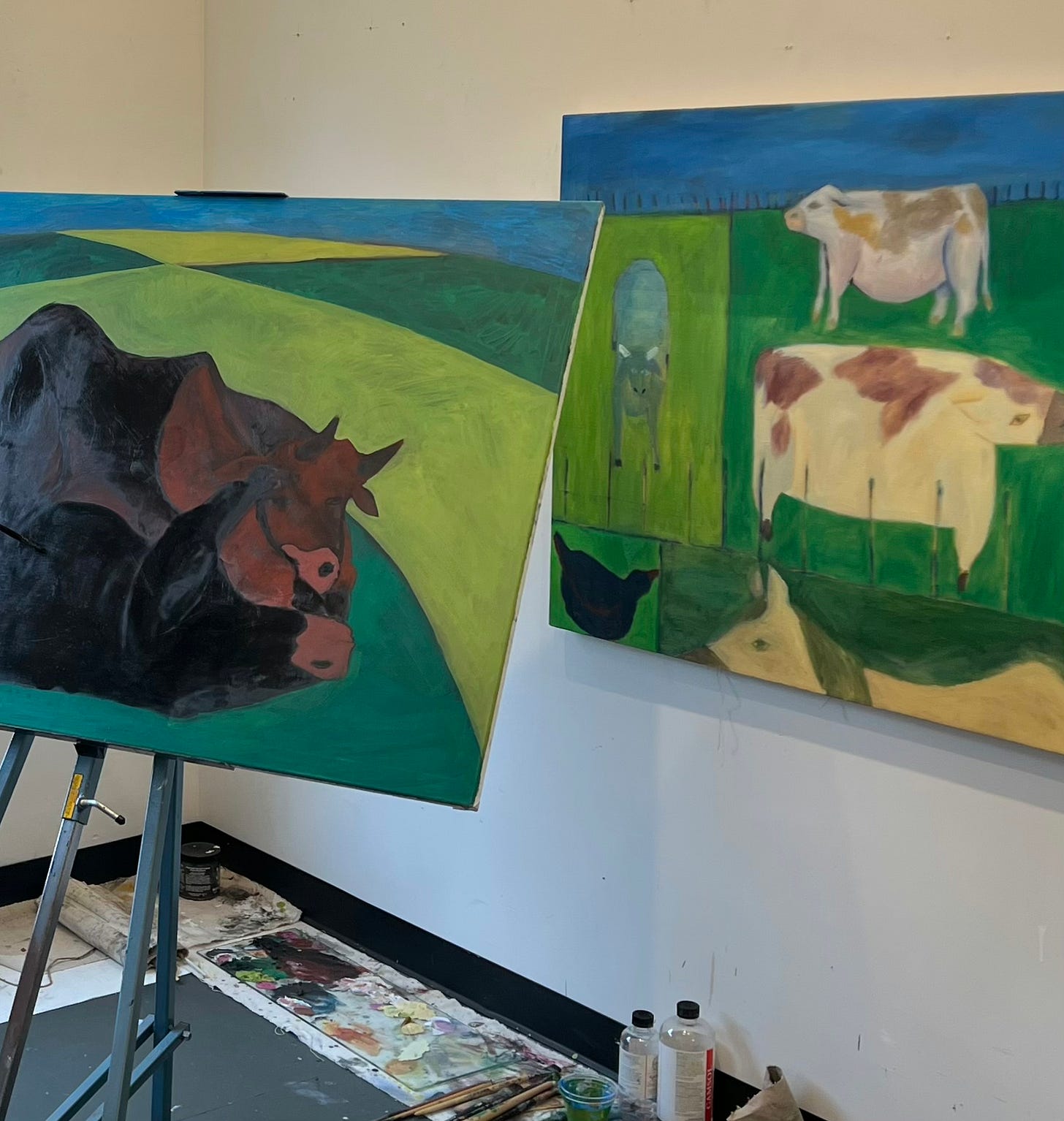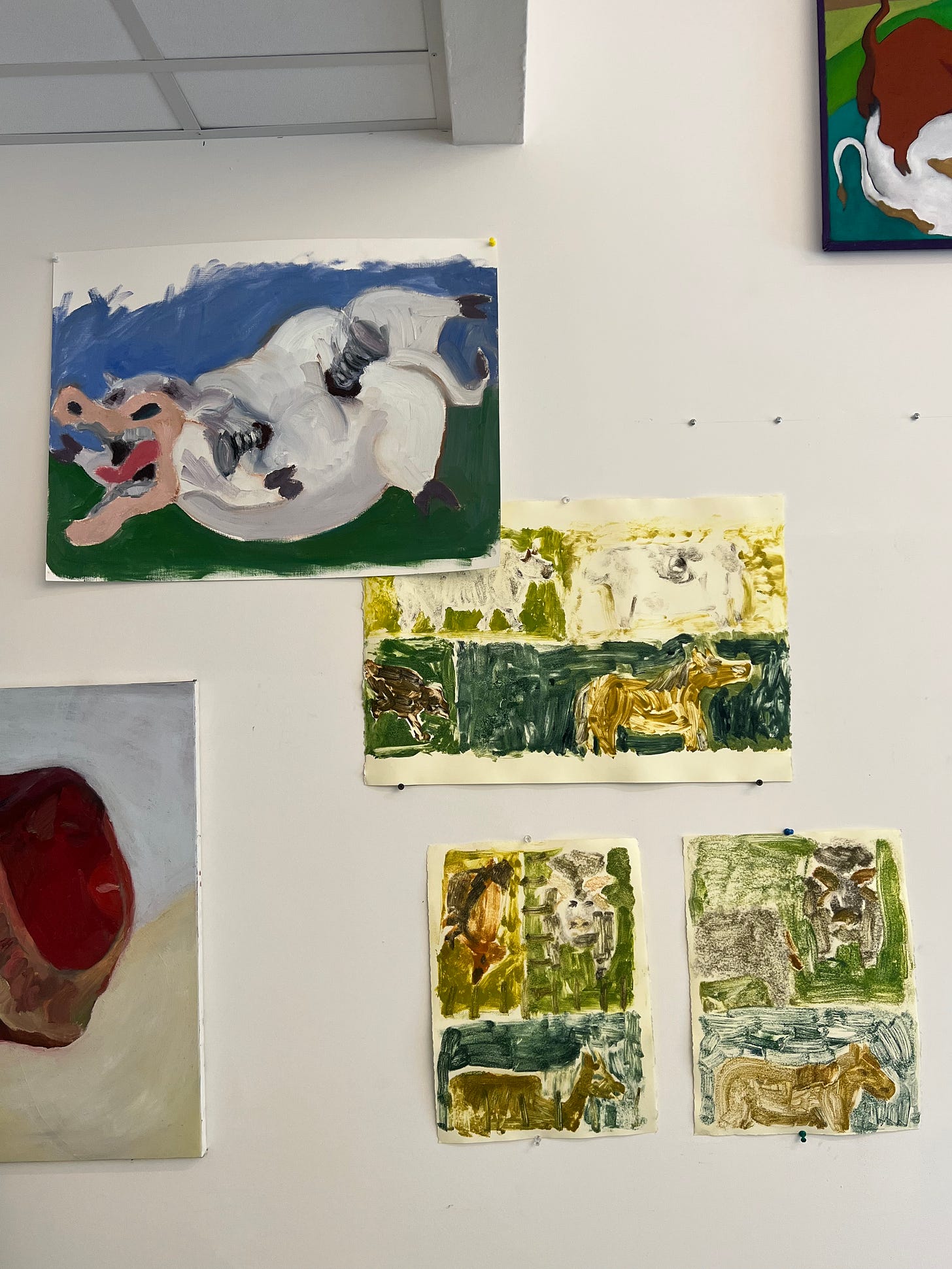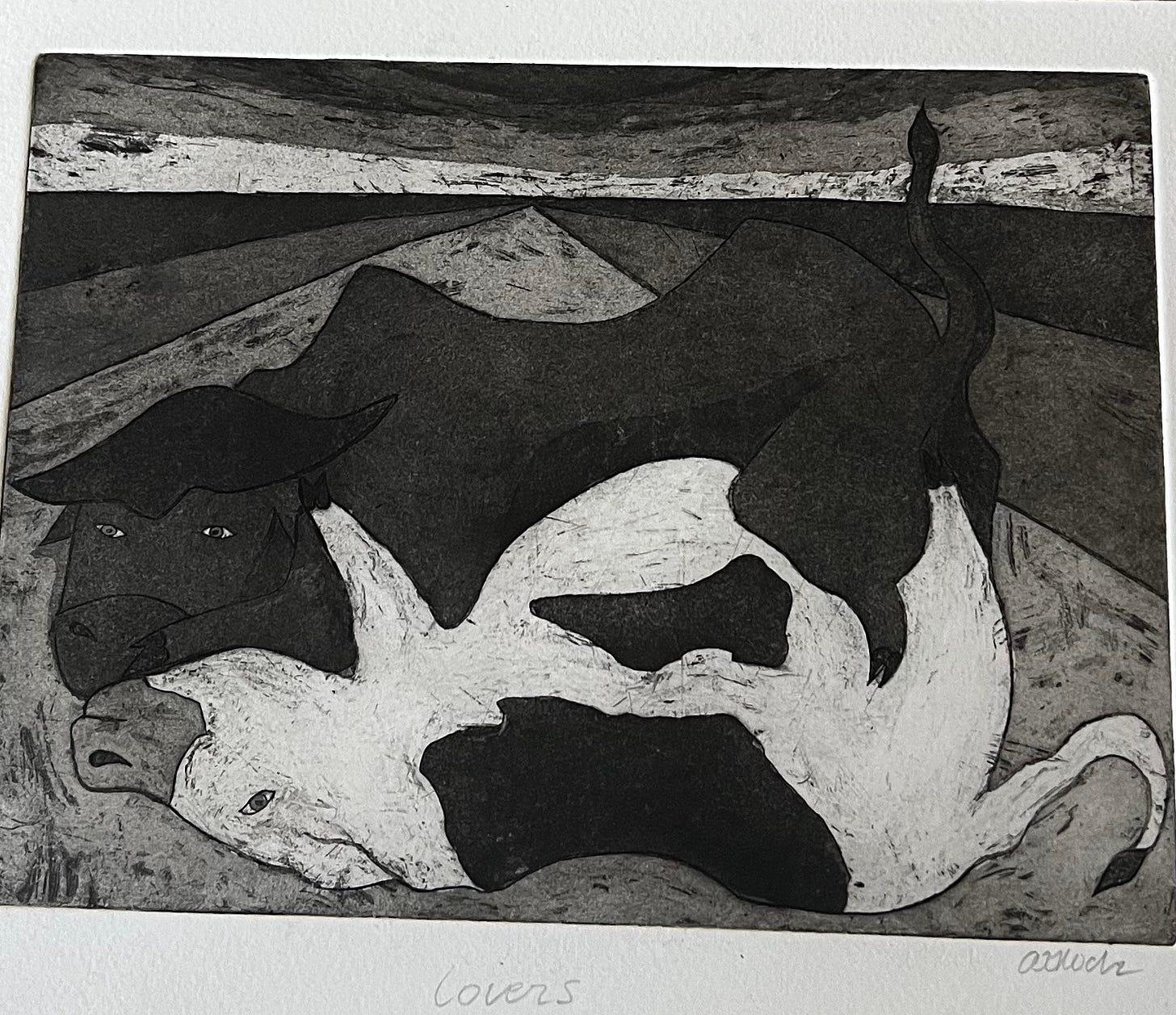“Cow,” oil on canvas, 44x40”.
Perhaps the best part of my completely random job is the role I play in curating one of several galleries on Pratt’s campus. I’ve attended around 20 exhibitions of student work at Pratt since January, both undergraduate and graduate thesis shows and student collectives, searching for work for our gallery, and Ariel’s pieces stood out to me above all others. There is something undeniably striking about an enormous, matte cow hung on a white wall, breaking the atmosphere of the gory and self-reflective abstractions of its peer group. I tracked Ariel down over Instagram initially to buy a work of hers—which I’ll attach a photo of—but then asked if I might meet with her in her studio to talk cattle, and the evolution of her practice. In this interview, she leads us down the path of self-resistance, describes the benefit of dislocating ourselves from our own artwork, and introduces me to Susan Rothenberg, both an abstract and figurative painter notable for her depictions of horses. “The horse was a way of not doing people, yet it was a symbol of people, a self-portrait, really” (Acquavella Galleries), Rothenberg said, and the horses were subjects that allowed her to “negate painting as much as possible, in terms of illusionism and shadow and composition” (MoMA). The same themes appear clearly in my conversation with Ariel. The following transpired in Ariel’s studio on Pratt’s campus, and on my lunch break:
Where are you from?
I grew up in Washington D.C., in Georgetown. I'm half Italian and was born there, I’m very close to my family over there.
Do you go ever back?
Not very often. My parents are really in and out of New York a lot. My mom recently has been running a lot of marathons, so she's been in New York for the marathons. I see her a lot, actually. So yeah, I haven't actually been to D.C. in a while. I go like every, like, maybe once every six months or something for a few days.
Where do you live in New York City?
I live in Clinton Hill, right around the block from Pratt. Very convenient. I’ve been living in the same spot for like three years. I live by myself—one bedroom.
Do you have your paintings in your apartment as well?
I have a lot of my paintings there. It's kind of weird, because I have a lot of them hanging. For storage, basically, but then it also looks like I just am surrounded by my own work all the time. It's like having an office full of mirrors. I've been slowly collecting work from other students and stuff like that, so now I've been able to introduce some more paintings and artwork into the space.
What's the first piece of art you can recall making?
I drew a lot when I was a kid. A lot. My parents would put me in a room and I would just start drawing. I was very much into my markers and stuff. I remember making a birthday invitation when I was really young, and I was copying rainbow fish. I also was like, really young, so I probably didn't really do much drawing, more like watching people draw. When I was really young my mom, I remember, she took the shavings of sharpened colored pencils and was using the pencil shavings to color in my drawings, very softly, it was sort of pastel-like.
Ariel in her studio.
Can we talk about the cows? Why the cows?
Well, there isn't a reason. I mean, I think they've grown to have more reason now. But when I first started painting cows, I had just gotten a really small circular canvas and I was like: Oh, I just want to paint a cow on this. And then I just really liked doing that. So then I made more circular canvases, painting a bull and a cow again, and then it just kind of evolved. I feel like I got really lucky. I found a subject that I just really liked to draw.
There's a quote from this artist I like, Susan Rothenberg. She's a New York painter from the ‘70s. But she was doing all these horse paintings. They were kind of abstracted, very object-like horse paintings. And she has a quote that’s something about how she likes to paint horses because she has no emotional attachment to them. It's easier. And I feel like that. I like painting figuratively, but it's a lot of pressure to paint—when you have so many choices for what somebody looks like, to either have a model or come up with it in your head is a lot. So I think yeah, those are kind of like an easier avenue. It feels more free somehow.
I can see that. Also, a cow is not going to look at your painting and assess the way in which you painted the cow. Whereas I guess if you have the human subject—it’s a different kind of perception and judgment.
Yeah. There's also just so much about identity in painting right now. I just, I don't know if I have anything to add to that right now. So, I feel like cows are good for me. I'm branching out to horses and chickens.
What do you mean by there's a lot with identity happening in art?
I just feel like—I mean, I don't know that much about art, even though I’m graduating—but I feel like there’s a lot about representing the self and who we are, portraits where the person's wearing a very specific thing to represent their sexuality, or like a piercing or a tattoo speak about who they are. And I like very old figure painting. I like just a naked woman on a couch. If I want to make work, I want to come at it from a different place. Something that just feels more simple to me. I don’t really have a lot to say, I don’t really paint about who I am.
I say the same thing about writing. I always want to write about other people. It's hard for me to insert myself into all my writing, it feels personally sort of exhausting. And similarly, we’re in a time where memoir is taking off so much. It is nice to create a separation between yourself and your work. It allows you to be more creatively free sometimes.
Yeah, it just takes the pressure off entirely. Removing yourself is liberating.
“Mother,” oil on canvas, 16x20”.
So when did you start painting the cows?
I drew my first cow in the fall of my sophomore year. My ex-boyfriend has that drawing. I kind of forgot about it and then remembered and was like, fuck, he has that drawing, I really like that drawing. So I decided to do more drawings. And then I made like 10 that night and I was like, whoa, this feels really good to make all these cows. Then I started painting them. And then I'd say they kind of started taking off in my junior year. So ever since, that's been kind of a thing. And then I went through a phase at the beginning of this year where I was painting a lot of screws. Now, I'm leaning into this fence idea, organizing the painting in a kind of grid with these fences. With the fence, they become farm animals. But also, I guess, when I first started doing it, I was just thinking about how it's a good visual tool to show distance.
That's so interesting you say with the fence they become farm animals. That's totally true. Without the fence, it's a cow, not cattle.
Yeah, they're all so free in all the other paintings.
Yeah, they totally are, and even their stature is more contained in the paintings with fences.
They could never do this on a farm [gesturing to cows having sex].
That reminds me that you have a painting where a cow is eating another cow.
Yeah, it's kind of wild. That one's fun. It's super different compared to my other paintings. And it's definitely the most different approach I've taken towards a painting. For that one, I was doing studies and preparation, looking at other paintings. I was looking at Hieronymus Bosch, Garden of Earthly Delights. So this is my most academic painting of the year, in terms of just my process for it.
“Field of Cows,” oil on canvas, 66x33”, a painting inspired by Hieronymus Bosch’s Garden of Earthly Delights.
What about this guy in the bottom right?
Yeah, that's a dead cow. Underground, dead. I left the underpainting for that cow because I thought it was symbolic, decay, I don’t know. It just felt like too much to paint in that cow—if it’s dead, it's dead. It's done. This one was fun to play around with because this becomes an equation. It's almost like this is the mother that represents Life and it's the same size as death. And leaning against the Death is this one eating a cow, and this one killing a cow. I felt really tripped out making it, just playing with those concepts.
Which painting is your favorite of the ones that you've made?
I feel like this one [pictured below], honestly. This is the most recent painting that I've made. And it feels the most like…I can see how I’ve grown as a painter when I made it. It's very simple, but I feel like it packs a lot. I'm really obsessed with this fence idea. So I like that it's just two squares. And another painting, that big white cow. I feel those two are the paintings where I'm like: I would not have thought that this is how my paintings would look from where I started. So it’s satisfying and cool to see that, and it makes me want to work more in that style, more single cows looking at you in different ways, brushstrokey. And more fences. And just kind of toeing the line, keeping things abstract-ish, fun and playful.
Ariel’s favorite of her work, “Farm,” oil on linen, 34x40”.
They really are. That's what I love about them, is that they seem so playful. And then the longer you look at them, the more you're like…whoa, there’s some shit going on here.
There are some cows eating each other.
Cows fucking in the back. Dead cow, cow getting murdered, cow being eaten.
Yeah, it's fun. It's really fun. It takes the pressure off. You can do pretty much anything with a cow and it’s not as impactful as if they were human. If I painted this and they were humans it would be really disconcerting.
Can you talk about a hurdle in your art career and a success in your art career?
I mean, I’ve graduated from art school. The hurdle is: what do I do next? I really like making jewelry, and I've taken many, many jewelry classes at Pratt. So I guess it’s not really a hurdle, but a fork in the road is: what do I want to do? I want to focus more on jewelry, and still produce paintings and try to land shows, but not make that my priority. And I don't know if I want to work as an artist assistant for a painter. Conceptually I'd be there but I don't know if I would want to—and stretching canvases and stuff would be fine—but I don't know if I'd want to brushstroke paint for other people. It seems hard, or seems emotionally difficult, like: this is not my painting.
NSFW cows.
I have always been so confused by that arrangement—like what a weird favor…what a strange, pretend situation. Ghostwriting is, I guess, the same way.
Yeah, I look at the Renaissance model of a house or operating under the House of DaVinci or something. You’re in the house and the paintings that you produce—I mean, it's kind of culty—but it's all supposed to look like this one person made them. Somehow it feels like there, the lines are more clear. There's just so much art in the world, there's so much everything, that if you can’t just do it yourself, why are you making other people do it for you? For something like a painting, a painting shouldn't be rocket science. You don't need to have so many people working on it. But I mean, that's also kind of judgmental. Everyone has their own practices. Maybe, I don’t know, I’ll meet an artist who has a studio and assistants and I’ll totally respect them for their setup. But from an outsider perspective, if you don't have the ability to do this, there's so many artists and so many paintings that exist, you shouldn’t hire people to do it for you.
Cow and horse studies on Ariel’s studio wall.
What's a work of art that you find inspiring?
I grew up with a print of a Botero horse. Fernando Botero, he’s Colombian. He's really old, if not maybe dead now, but he was really known for making these paintings—just really robust people. Not necessarily like he was painting big people, but making people bigger and making animals bigger. Like, with a fruit bowl, the fruits would become the same size as the bowl. I totally forgot that that was in my basement my entire childhood and then I remembered that and thought, wow, that’s crazy because I feel like I'm channeling him now, with animals being kind of humanoid and oversized.
What do you feel has been a success in your career?
I'm happy that I've been able to preserve playfulness in my work. I think that's something that I'm proud of, even if it's a light thing. There's a lot of heaviness in the world so to be able to just make stuff that's kind of fun and beautiful, and that people seem to respond to feels, yeah, successful.
I think it stands out in a room for that. When I went to that BFA painting show, I was drawn to it immediately. Because, first of all the scale of that first big cow by your name, but also because I think, especially at an art school, within an age group of people between 18 and 22, there is often a lot of darkness and concern with personal identity. So in a lot of the thesis shows I've been seeing, there's some really dark art happening. But these are so fun, you know, light-hearted and striking.
Yeah, that's my goal. I want to keep things light and I really like funny artwork. I like when artists are able to fit an inside joke into their painting, which seems almost impossible, like how do you deliver a joke that way? But I love that quality, when you see that.
Well, my next question was what would you do if not paint? But I guess jewelry is kind of the answer.
I feel confident that I could be fine in almost any sort of pursuit that was hands-on, making things. I worked in a ceramics studio for a bit, I liked that. I could work for a jeweler. I will just be fine as long as I’m making something. And be anywhere. The hurdle is making a decision.
“Lovers,” an etching.
At least it's not like you have to funnel your life into one of two shitty options. You just have to be overwhelmed by all your options.
That’s what I tell myself. There's a lot of disadvantages to an art degree, but the one advantage is that you can justify going anywhere. That just seems like an option that a lot of people don't get right after college.
Do you think you’ll stay in New York?
I'm not sure. I have my lease until September. So I have a lot of time between now and then. I have a lot of options. I have dual citizenship in Italy so I could go anywhere in Europe. I lived in Berlin for a little bit before coming here and I recently saw my friend that I met in Berlin. So now I'm like, oh, maybe I want to go there. I just want to be somewhere that’s inspiring.
You can follow Ariel on Instagram, where she has a few etchings still available for purchase, and many more cows, and fences, to come.

